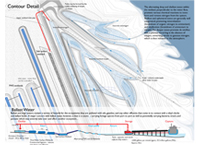The Red Ribbon - Tanghe River Park
The High Line
For background, go here: http://tulloch.rutgers.edu/Candidates.html

Comments and news about Environmental Planning and Design. Intended for all audiences including students and alumni of the Rutgers major of Environmental Planning and Design.
 NYC was the first megacity - Now there are 18, soon there'll be 27
NYC was the first megacity - Now there are 18, soon there'll be 27



The goal of the Mannahatta Project has never been to return Manhattan to its primeval state,” Sanderson writes. “The goal of the project is to discover something new about a place we all know so well, whether we live in New York or see it on television, and, through that discovery, to alter our way of life. New York does not lack for dystopian visions of its future. . . . But what is the vision of the future that works? Might it lie in Mannahatta, the green heart of New York, and with a new start to history, a few hours before Hudson arrived that sunny afternoon 400 years ago?
- NYT Book Review, Robert Sullivan, 5.22.09


 Explore and enjoy.
Explore and enjoy.
The Sustainability Science Program
Harvard University
Center for International Development
*________________________________________________*
*Fellowships in Sustainability Science*
Harvard University's Center for International Development
Due date for applications: December 1, 2009
The Sustainability Science Program at Harvard University's Center for International Development invites applications for resident fellowships in sustainability science for the University's academic year beginning in September 2010. The fellowship competition is open to advanced doctoral and post-doctoral students, and to mid-career professionals engaged in research or practice to facilitate the design, implementation, and evaluation of effective interventions that promote sustainable development. Applicants should describe how their work would contribute to "sustainability science," the emerging field of use-inspired research seeking understanding of the interactions between human and environmental systems as well as the application of such knowledge to sustainability challenges relating to advancing development of agriculture, habitation, energy and materials, health and water while conserving the earth's life support systems. This year we will give some preference to applicants who address the challenges related to meeting human needs for water or food/agriculture/land use in the context of sustainable development. In addition to general funds available to support this fellowship offering, special funding for the Giorgio Ruffolo Fellowships in Sustainability Science is available to support citizens of Italy or developing countries who are therefore especially encouraged to apply. The Sustainability Science Program is directed by Professors William Clark and Michael Kremer, and Nancy Dickson. For more information on the fellowships application process see http://www.cid.harvard.edu/sustsci/fellowship. Applications are due December 1, 2009.
This seemed well worth passing along:
STERLING FOREST CONSERVATION DAY
SUNDAY, SEPTEMBER 27
Enjoy hikes for all ages amidst the fall foliage!
On Sunday, September 27, the Sterling Forest Partnership will hold its 11th Annual Sterling Forest Conservation Day with a variety of hikes in Sterling Forest State Park.
Between 9 AM and 1:30 PM, hikes will leave from the park's Lautenberg Visitors Center at 116 Old Forge Road, Tuxedo, NY 10987, off Long Meadow Road, approximately five miles north of County Route 72 or approximately four miles south of NY Route 17A.
Donald 'Doc' Baynes, environmental educator and historian of Sterling Forest, will lead two regional history hikes on the Lakeville Ironworks Trail -- at 9:30 AM and at 1:30 PM. Doc will explain the importance of this iron rich area during both the American Revolution and the Civil War.
There will be family hikes around Sterling Lake and to the 60-foot Fire Tower leaving at 10 AM. Other hikes will depart as demand dictates.
The Sterling Forest Partnership, formed 22 years ago, was instrumental in the preservation of Sterling Forest and continues to advocate for protection of the park and its surroundings.
For further information, please contact Sterling Forest Visitors Center 845-351-5907 or Tom Thompson 201-848-1080.
On Monday, September 14, the New Jersey Presidents' Council Executive Board approved our proposal for a Master of Landscape Architecture program. Starting this program has been a goal of our Department for many years and we plan to accept our first class of students for the Fall semester of 2010.
Many people have made this possible. Executive Vice President Phil Furmanski, SEBS Executive Dean Robert Goodman, SEBS Dean of Academic Programs Jerry Kukor, GSNB Associate Dean of Academic Affairs Harvey Waterman, and Senior Academic Planning Associate Jim Burkley have all been steady, persistent, and strategic in helping this goal become a reality. The current and past faculty of the Department of Landscape Architecture have all offered help and advice.
Now we must get down to the hard work of recruiting, accepting, and teaching. Prof. Dean Cardasis has shepherded the proposal through committees for the past year and is our first Graduate Program Director. I know he will benefit from the collective knowledge and support of this community.
I am personally eager to participate in writing this new chapter in the history of the Department of Landscape Architecture.
Best regards,
JeanMarie Hartman, Ph.D.
Chair, Department of Landscape Architecture


















